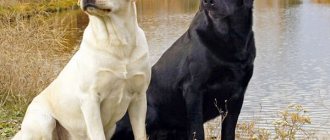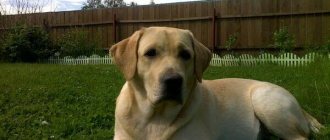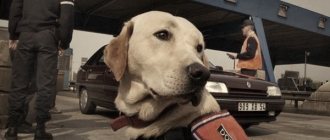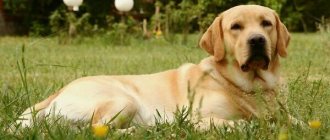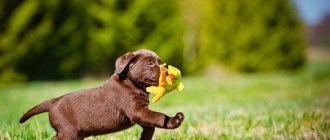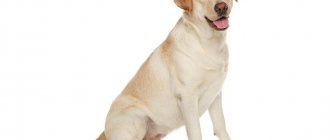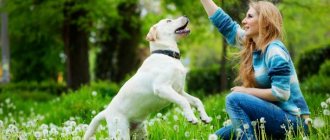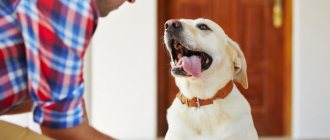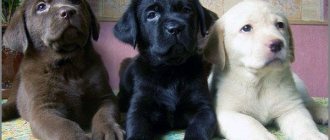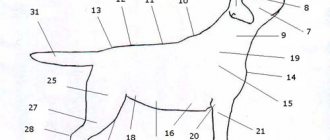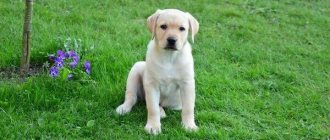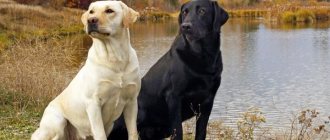Labrador hygiene
Labrador dog hygiene includes caring for the coat, nails, teeth, skin and ears.
There are certain rules for caring for a dog of this breed. Labrador Retriever dogs have been one of the most popular pets for many years. If we consider large breed dogs, Labradors are not considered the most demanding pets in terms of caring for them. But this does not mean that the future owner of a dog of this breed can ignore the rules of Labrador hygiene. High-quality care for your pet’s fur, claws, mouth and ears will help maintain its external attractiveness, as well as avoid ear and skin diseases.
Breed Features
These are cheerful, kind, loyal, reliable dogs with high intelligence.
Labradors are excellent hunting helpers. They are obedient and easy to train. They love to move and swim a lot. They reach speeds of up to 20 km/h on land and up to 5 km/h in water. These dogs have a coarse coat and dense undercoat and thrive in cold conditions. They have a keen sense of smell and a special, “soft” grip, which allows them to carry shot game without squeezing it with their teeth. The working qualities of Labradors help them hunt in hard-to-reach places.
It is not worth getting a Labrador for security purposes. These are peaceful dogs that are not capable of biting anyone. They can only bark to warn the owner that a stranger is approaching.
For their intelligence, stable psyche, and keen sense of smell, Labradors are used as rescuers and search engines. They are equally good at finding people under rubble, as well as narcotic and explosive substances.
The peaceful, friendly disposition of this breed makes it possible to raise excellent helpers for people with disabilities.
Labradors mature later than other breeds. Psychological maturation occurs closer to three years.
These dogs need long walks and exercise. Firstly, they are prone to obesity, and secondly, in order not to get bored, they need to expend all their irrepressible energy.
Labradors tolerate traveling by car very well.
The conditions of a city apartment and a private house are suitable for keeping a Labrador Retriever. They can also live in an aviary.
This is perhaps one of the funniest breeds. The Labrador is always ready to keep his owner company and you won’t get bored with him!
READ Interesting data and facts about rhinoceroses
Wool
A shiny and thick coat is the main decoration of any dog, and the Labrador is no exception. You need to think about the hygiene of your pet’s fur before he arrives in the house. Even though a dog's coat is easy to brush and wash, there are certain hygiene rules that must be followed.
The Labrador's coat consists of a thick, soft undercoat and long, non-curly but thick hair. Several times a year, a dog of this breed sheds intensively, which creates a lot of trouble for the owners associated with cleanliness in the apartment. Brushing helps to quickly cope with the consequences of shedding. This procedure allows you to clean the coat of dead hair, as well as reduce the frequency of cleaning your home. Combing is also necessary in the spring and summer, when the dog needs to be regularly checked for ticks. They also comb the dog after walks in the forest, after which dry leaves and thorns remain on the animal’s fur.
Caring for your Labrador's coat begins with choosing the right brushing tool. As soon as a puppy appears in the house, you need to purchase several combs. One of them is the furminator - a device for combing dogs and grooming. The advantages of a Furminator for Labrador are as follows:
- The comb effectively removes dead hair without damaging the dog’s skin;
- promotes uniform distribution of natural skin lubrication;
- provides prevention of tangles;
- reduces the duration of seasonal molting.
For Labradors, you need to purchase a large furminator, which allows you to process large areas of fur at a time. The Furminator is used after preliminary bathing and drying the coat. If you don’t wet your dog before brushing, the teeth of the device will quickly become clogged with dirt and ruin the healthy coat.
The Furminator is a device that is recommended to be used no more than once a month if the dog does not shed. During the molting period, the number of procedures is increased to two per month.
To care for the coat, you also need to buy a comb with fine metal teeth. You will need it to comb out ticks, dirt and thorns, which not only spoil the coat, but also pose a threat to the health of your pet.
Fight against worms
Most often, Labrador is found with roundworms or tapeworms.
They can be found in the intestines, where they take all the nutrients.
If a severe worm infestation is detected, especially in children, it can cause a noticeable deterioration in the dog’s condition. Most often, roundworms attack puppies.
Adults do not often pick them up. Sometimes puppies are born with roundworms, or rather, their larvae.
This is why serious breeders remove worms from puppies more than once at the age of two months.
When purchasing a Labrador, you should ask the breeder what product he used and at what period the course should be repeated.
If this infection is not cured, it threatens the health of the Labrador and the people around it. Young children should be especially protected from this fact.
You need to make sure that your dog is constantly protected from worms and does not lick children.
As mentioned, adult dogs are less likely to have roundworms, but they are often attacked by tapeworms.
The carriers of their eggs are fleas. If a flea bites a dog, the second one is already infected with tapeworms.
There are an impressive number of tapeworms. Humans are especially afraid of the “bovine” tapeworm, which is carried in the intestines of sheep, as well as large horned animals, fish and game.
To carry out anthelmintic treatment for a retriever, you can purchase different medications. As a rule, only roundworms are removed from puppies.
Combination drugs are excellent for treating adult pets, as they affect both tapeworms and roundworms. The drug is dosed strictly according to the weight of the animal.
A Labrador needs anthelmintic treatment once a quarter, especially if there are small children in the family.
Raw carrots, pumpkin seeds, garlic, etc. are perfect for this purpose, but this does not provide a 100% guarantee.
Claws
Nail trimming is an unpleasant but necessary procedure for a Labrador dog. You need to accustom your pet to nail hygiene from the first months of life. A puppy's claws grow quite quickly, causing the dog's toes to become splayed, which interferes with the formation of healthy limbs.
To trim the puppy's cat, use manicure clippers designated for dog hygiene. The procedure must be performed very carefully, cutting off only the “hook” of each claw. If the owner accidentally cuts off the part adjacent to the puppy’s finger, this will lead to bleeding and severe pain, after which the animal will be afraid of the nail trimming procedure for quite a long time.
Adult Labradors, whose limbs are properly formed, sharpen their claws during walks. But do not forget that dogs have a fifth toe, the claw of which does not grind off on a hard surface. It is this claw that needs to be trimmed using a nail clipper purchased at a pet store.
A puppy should be taught to brush its teeth from the age of one. For the procedure, purchase a special toothpaste and brush for dogs. When brushing your teeth, try to thoroughly clean your back teeth, as a lot of plaque accumulates on them.
Outdoor content
Labradors are a domestic breed, and it is highly undesirable for them to constantly live outside.
This especially applies to puppies, who are sociable and affectionate creatures. Labradors living in a private home are the luckiest of all, because they are provided not only with cozy housing, but also with an excellent playground. As in the apartment, an enclosure for the dog is being built in the yard, in which the place of the bed should be taken by a full-fledged kennel on an elevated island. A Labrador's kennel must be large and strong so that the dog can fit in it completely and comfortably. Standard kennel sizes for this breed are 110 cm in length, 90 cm in width and 80 cm in height.
Ears and skin
Labradors are dogs that have floppy ears. Due to their anatomical features, the ears are poorly ventilated, which increases the tendency to inflammation. Several times a week, the dog’s ears should be wiped with a cotton ball soaked in saline solution. You can also buy a special ear care product at your veterinary pharmacy.
The condition of the ears and skin should be regularly monitored. As soon as symptoms such as redness, flaking, an unpleasant odor and scabs appear, you should immediately take your pet to a veterinarian.
Features of wool and its care
The coat of this cute breed is such that it is difficult to get the dog wet. The animal is covered with natural fat from the sebaceous glands - in the cold water of the lake, a Labrador is able to swim for a long time after a shot duck, then get out, shake itself off and not lose body heat. The undercoat is thick, allowing you not to freeze in severe frosts!
The concepts of “washing” and “bathing” are different. In the first case - with shampoo, in the second - without. Washing wool and undercoat is an important task that does not require frequent execution. Washing with cold water without shampoo slows down hair loss and growth; washing with warm water, on the contrary, speeds up the change. Using this method, it is possible to speed up the course of seasonal molting. Don't forget to scratch.
Washing and bathing
You should wash your dog with shampoo (specialized - otherwise it’s easy to damage the coat) three times a year, not more often, or if the dog has been handled extremely hard. Moreover, when washing, it is necessary to wash the layers of wool and rinse thoroughly due to the good water-repellent ability of the outer wool. After a walk, if necessary, just rinse the dog in the shower or under a hose in the yard, then simply wipe it with a rag or towel.
Dogs love to splash around. Even puppies love to swim. From the age of two months, you can safely let the puppy frolic in the water, dry it thoroughly and let it dry in a warm place. In the latter case, there is no need to wet the dog “through and through”.
Washing is not a very favorite event for a dog, like trimming its nails, examining its ears, eyes and mouth. When you are about to wash a reluctant puppy, calmly continue what you started. Gradually, the puppy will learn that you are the owner and set the washing time and inspection time. Otherwise, the dog will understand the opposite, and teaching him to stand calmly in the bath will be problematic in the future. It is necessary to scratch from a young age, so that adaptation to the procedure occurs quickly; some dogs then stand and wait for the owner to comb out the hair.
Checking the eyes, ears and mouth is carried out immediately after combing; it is advisable to accustom the dog to order from an early age.
Walk
You need to walk an adult Labrador twice a day before feeding. The total duration of walks should be 2 hours. On weekends, it is better to set aside 3-4 hours so that the dog can use up all the accumulated energy.
Labradors have a genetically built-in need for exercise. Just a few laps around the park on a leash is not enough. We need fetching and outdoor games in which the owner will act as a partner. The active participation of the owner is the key to the dog’s good mood.
An ideal activity would be swimming. In winter, the water will be replaced by snowdrifts.
When can you bathe a puppy for the first time?
How to care for a dog, what conditions will be optimal and how to provide them - these are questions that need to be asked before purchasing a pet. If you have already chosen a baby and are going to take him home, it makes sense to find out when you can bathe the puppy for the first time. There are no strict restrictions in this matter, but you should still listen to the recommendations of experienced breeders.
First bath
The first bath should be as comfortable as possible. The wrong approach can frighten the baby and make washing in the future not a pleasant experience, but a terrible execution.
Following simple rules will help you to endure this activity calmly, and perhaps even fall in love with it:
- the water temperature should be close to the dog’s body temperature – 36-40 degrees Celsius;
- the bottom of the bathroom should be covered with a rubber mat, diaper, towel so that the pet’s paws do not slip or move apart;
- water should not get on the face, eyes or ears;
- The wool should be well moistened before applying shampoo;
- do not apply shampoo directly to the coat - dilute it in a small amount of warm water, this will make it easier to foam and avoid intensive soaping, which can tangle the coat;
- Lather your back first, carefully moving up to your head, rinse off the shampoo the other way around - from your head down;
- repeat 2 times;
- After bathing, wrap the puppy in a towel, dry the coat well, let it dry almost completely, then dry it with a hairdryer and comb it.
You can read more about bathing in the articles: “How often can you wash a dog”, “Caring for a dog’s coat”. Possible problems with fur due to improper care are described in the article: “Dandruff in dogs and methods of treating it.”
Characteristics
Labrador Retriever is a dog with a large head, powerful neck, and broad chest. He has a strong build with well-developed muscles. The paws are neat, round in shape. The tail is thick at the base, tapering towards the end. For this reason it is often compared to an otter's tail.
The coat of these dogs is short and harsh, with a dense undercoat. Three types of color are accepted as standard: black, fawn, chocolate. A small white spot on the chest is allowed. The Labrador Retriever should not be confused with the Golden Retriever. These are different breeds. The latter has longer, cream-colored fur.
The average height of a male is 56-57 cm, females 54-56 cm. The average weight of a male is 27-40 kg, females 27-35 kg. Life expectancy is 12-14 years.
Advice
If this is your first pet, be sure to consult with the breeder and the vaccinating veterinarian about when you can bathe the puppy for the first time. To get acquainted with water procedures, choose a time when the baby is healthy, well-fed, and calm. Be sure to talk to him during the procedure, gently stroke him and reward him if he behaves well. You cannot raise your voice or use force - this will discourage you from swimming for a long time, if not forever.
Sources:
https://vetsystem.ru/porodi_sobak/labrador-retriver/gigiena-labradora/ https://dogcentr.ru/voprosyotvety/kogda-nachinat-kupanie-labradora.html https://lovely-dog.ru/uhod-za -pitomtsem/kogda-mozhno-kupat-schenka-v-pervyy-raz/
Breeding
Only pedigree Labradors participate in breeding in accordance with the plan drawn up by the club. At the age of two years, dogs undergo an admission test. This check should reveal defects that do not allow participation in breeding.
Conditions for admission to the test:
- age from 2 to 5 years;
- pedigree;
- participation in at least 3 exhibitions. Ratings not lower than “Very good”;
- passed training and endurance exams;
- X-rays confirming the absence of joint dysplasia;
- documents for identifying a male dog;
- document confirming testing for hemophilia;
- written confirmation from the owner that he is not aware of any hidden defects in the Labrador.
Test results are valid for 3 years.
If a Labrador is found to be defective in color, eye color, cryptorchidism, malocclusion, etc., sterilization is indicated. These dogs are not allowed to participate in exhibitions or breeding. The price of such puppies is much lower. Consider this option if you are not planning offspring and fame for your dog.
